PSVR 2 could be the hottest VR headset yet | Patent Trawling
Our newest feature debuts with a survey of Sony ideas that will raise/singe your eyebrows and a search for the first US gaming patent
Games industry patents are an interesting mix of futuristic ideas, practical applications, and utter nonsense. They can tip a company's hand as to what it's planning next, give an idea of how they're thinking about certain parts of their business, or let us revisit old successes and see how they were originally envisioned. Patent Trawling is intended to be a mix of all of the above. Not everything featured here has come to fruition, or ever will, but it will hopefully offer some insight into why the industry is the way it is, and where it might be headed next.
I've been fascinated with patents for a while now. In 2012 I started a Tumblr blog called Context-Free Patent Art, showcasing art from game-related patents and patent applications without anything to explain what it is the reader was looking at.
The results could be baffling, intriguing, nostalgia-inducing, and even beautiful, in their own way.
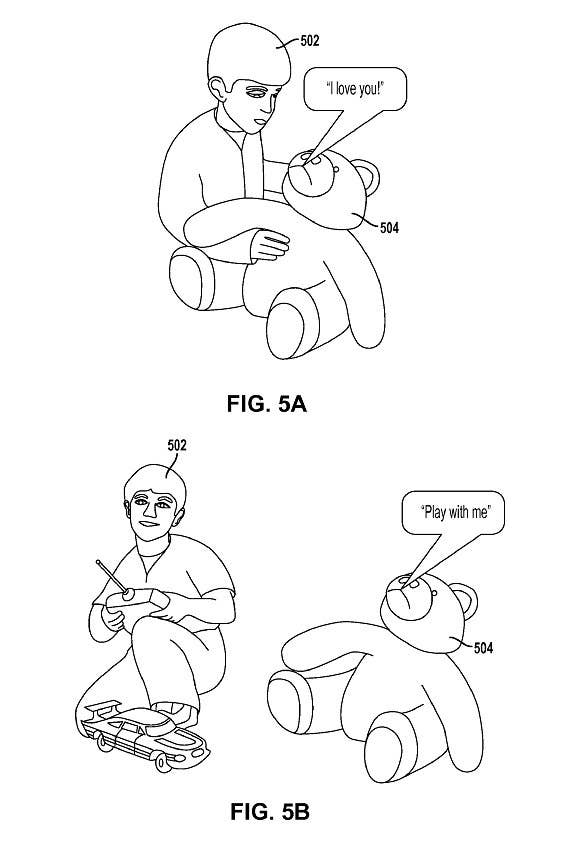
After a lengthy hiatus, I recently started updating the blog again, but increasingly found myself wanting to provide some context, like telling people that the emotionally needy teddy bear they were looking at was from a Sony patent application for devices that could track where people were looking, and then pester them to re-engage if their attention shifted elsewhere.
I wanted them to know this woman climbing a giant hamburger with a pair of bikes in the distance didn't make any more sense in the context of a 2002 patent application for in-game advertising.
These things usually aren't newsworthy in and of themselves, but the hope is that Patent Trawling can provide an interesting and worthwhile glimpse into the patenting process, letting us look back and see the dead ends companies explored, the Next Big Things they got in on the ground level for, and the as-yet-unproven technologies that could end up in either category.
Brainstorming PSVR 2 Features
Like many big tech companies, Sony is very active on the patent front, applying for patents on a whole slew of ideas. Often times the patents Sony seeks are for tweaks to products that already offer. Many of them never actually show up in commercial products, but they still give some clues as to what Sony and its designers were thinking.
For example, the company has a slew of patents regarding virtual reality and motion capture, ideas that it could turn to if it ever decides to roll out a successor to the PlayStation VR headset. (Even if PlayStation CEO Jim Ryan has suggested a next-gen headset isn't imminent.)
Considering one of PSVR's most appealing features was its cost compared to the other VR headsets on the market when it launched, Sony might consider using the technology in its 2019 patent application for an environment mapping/player motion-tracking system. The patent describes a tracking method that uses thermal data, swapping out the potentially pricey multiple camera setups of similar systems for an assortment of thermal beacons (like inexpensive infrared diodes) that can be placed around the room and a thermopile array in a controller to determine the player's position.
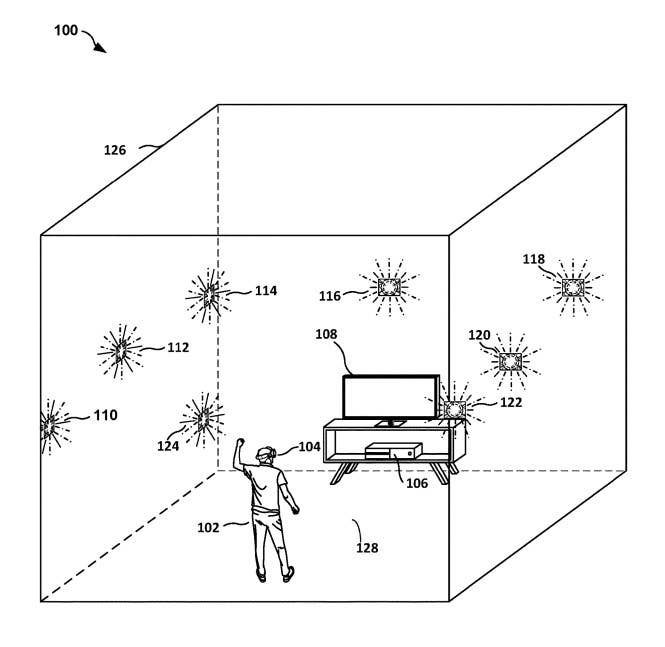
The company could also look dust off some slightly older ideas. In 2013, Sony received a patent for a "Temperature feedback motion controller" that looks like a Move controller with built-in thermoelectric heating and cooling systems so that a game could track where the user's hands are supposed to be in the game environment and warm or cool them accordingly.
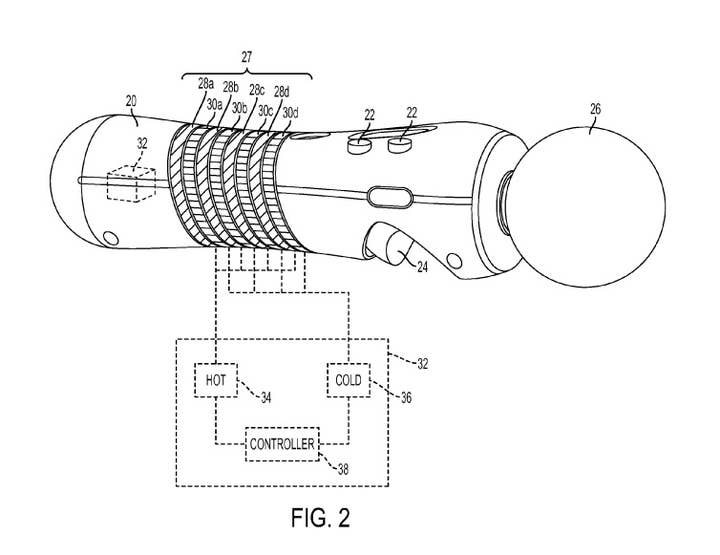
That could be combined with this patent applied for in 2016 for a "Temperature controlled headset apparatus," a VR headset with heating elements built into the eye piece that would allow players to, for example, "receive heat from a fireball created by the firing of a rocket propelled grenade (RPG), or feel the heat from the sun when transitioning virtually from an inside environment to an outside environment."
Another Sony patent application filed in 2018 would cover a similar idea, but accomplishes it with fans directing heated or cooled airflow. That patent also suggests using the airflow in the headset to help guide players to specific places in-game, or could be bolstered with a scent emitter to let players smell their in-game surroundings (presumably putting an end to sewer levels once and for all). Perhaps that would rely on this 2016 Sony patent application for a "Fragrance Presentation Device" to clear the air in between fragrances and prevent smells from lingering longer than would be appropriate.
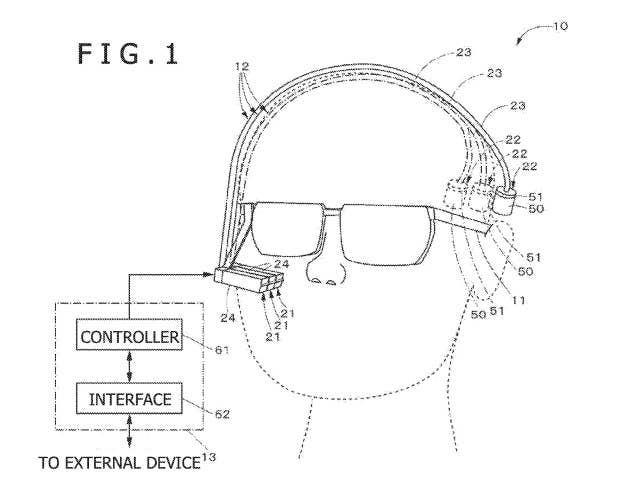
Considerably less silly is another 2018 Sony patent application involving a VR headset that would monitor the user's temperature, heart beat, dilation of pupils, motion, and more to determine if they were in a pathological state (epileptic seizure, heart attack, stroke, panic attack) and perform a series of actions that the user would have pre-set in case of such an event.
While it's laudable that Sony would consider how to use it for the benefit of players, making such a system work requires a frankly terrifying amount of personal information to have monitored on the regular by anyone who isn't your doctor. I can't say I'm comfortable entrusting all that information to the company willing to patent the aforementioned emotionally manipulative teddy bear, or this patent on dystopian advertising ideas like interrupting movies to show ads until the viewer says the name of the brand being advertised to them.

The First Gaming Patent in the US?
For the first installment of Patent Trawling, I thought it would be fun to track down the first US video game patent. It's a bit of a fool's errand in the first place given the varying definitions we might have as to what qualifies as a video game and the fact that I'm not willing to look at literally millions of earlier patents to ensure that none of them secretly fit whatever definition we would choose, so take this as a bit of fun rather than a formal declaration.
My first thought was that the earliest gaming patent might belong to Willy Higinbotham who created the game Tennis for Two on an oscilloscope in 1958, but he never actually patented that invention. He made it as an exhibit for a public event at the Brookhaven National Laboratory where he worked, so the government would have held the patent rights.
"It wasn't something the Government was interested in," he reportedly said, adding he "didn't think it was worth it."
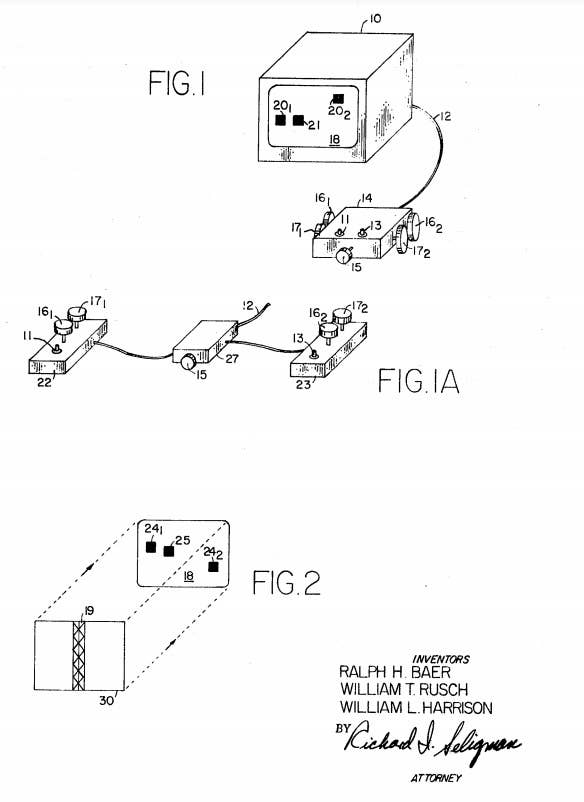
Another likely culprit would be Ralph Baer, "the father of video games" whose creations in the late-'60s at Sanders Associates would usher in the world of consoles. Fortunately, Baer's official website keeps a list of the late inventor's patents.
Unfortunately, the earliest one with any apparent relevance to video games -- one for a "Recording CRT Light Gun & Method" -- is listed with a patent number that points not to any patent of Baer's but instead to one for a multilayer boat hull, and the patent database won't let us search patents that old by the inventor's name or the patent's title.
The next earliest gaming patent of Baer's was filed in 1969 for a "Television Gaming Apparatus" that bears a strong resemblance to Baer's "Brown Box" that would later be turned into the Magnavox Odyssey.
However, that patent lists a number of previous patents it is building upon, among them a patent for a Cathode-Ray Tube Amusement Device filed by Thomas T. Goldsmith, Jr. (whose contributions to the early days of television technology were numerous) and Estle Ray Mann.
The patent describes a game where airplane targets are placed on the tube and players trace an electron beam across the face of the tube to hit them.
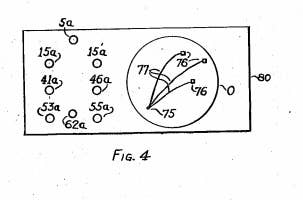
As it explains, "The game can be made more spectacular, and the interest therein both from the player's and the observer's standpoint can be increased, by making a visible explosion of the cathode-ray beam take place when the target is hit."
The previous patents it references include various cathode ray tube technologies and a gun sight for pilots, but nothing specific to video games as we know them.
Goldsmith and Mann filed for their patent in 1947, decades before Baer's still-pioneering work and the same year Hillary Clinton, David Bowie, and Tom Clancy were born. While they don't appear to have used their invention in any kind of commercial product, I think this is enough to argue that the video game industry is technically a baby boomer.
A Familiar Defence
While following a rabbit hole of earlier patents referenced in Baer's work, I came across this patent for a Television Dart Game filed in 1958. The patent itself is little more than a dart gun and a transparent shield to cover a TV so kids can safely shoot darts at characters that come on the screen in normal programming, but the explanation behind it is considerably more interesting.
"[S]ince the advent of commercial television, its possible adverse psychological affect upon children has been a major concern in view of the enormous extent to which television has come to pervade and dominate the child's perception of his environment. It is frequently held that television programs can be harmful to the child in that they stimulate the child's psychic energy to highly intense emotional levels, which energy the child cannot effectively discharge because of lack of any acceptable effective means of expression and release such as are available to the adult.
"The present invention attempts to obviate these harmful aspects of television by enabling the child to express his aggressions and other emotional states and to participate actively in the television program by shooting harmless darts at the characters, personalities, and other images appearing on the television screen."
Anyone familiar with the industry's frequent battles over the effects of violent games on children has probably heard some version of that argument. Perhaps most surprising is that 60 years and who knows how many studies later, there still doesn't seem to be consensus on how much water the argument holds.
